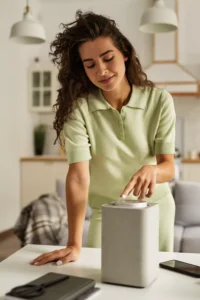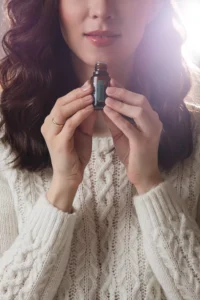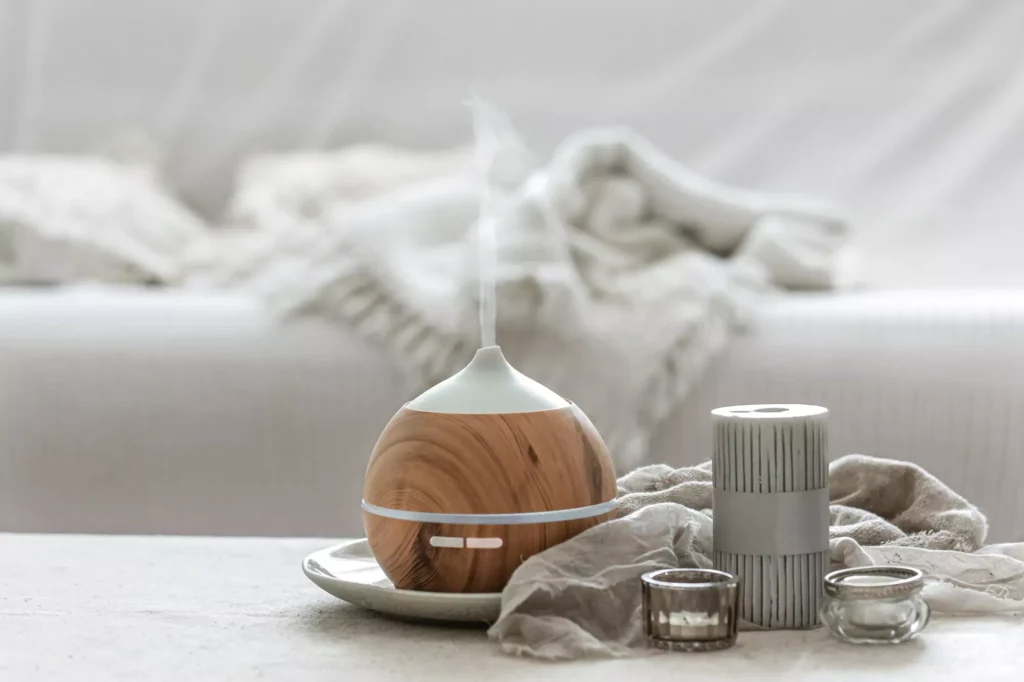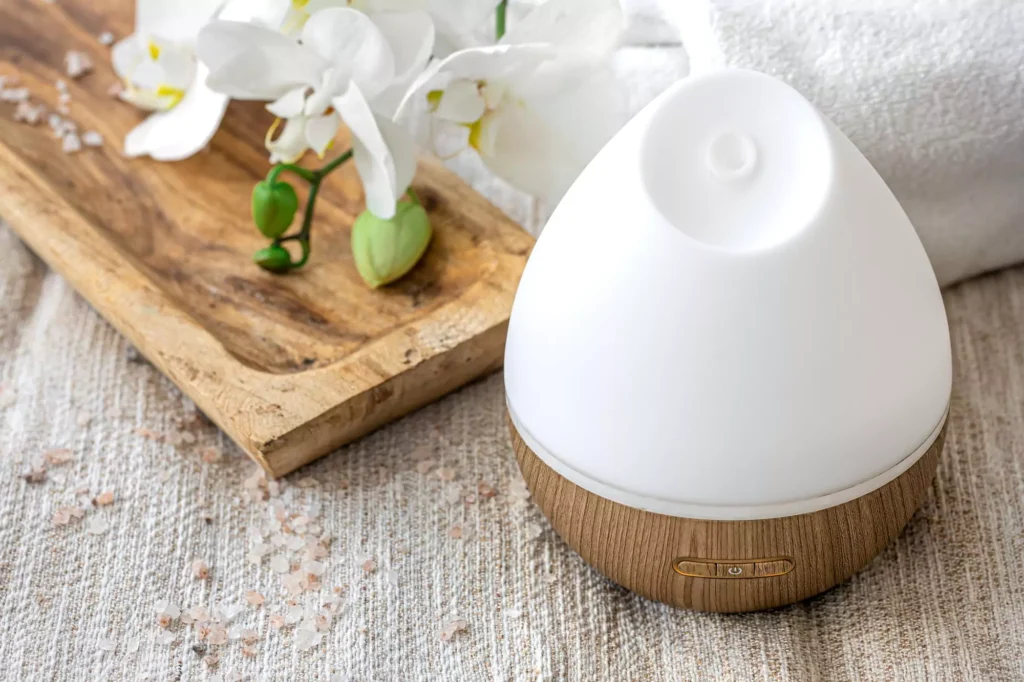You know that weird thing where you catch a whiff of something random… like my aunt’s snickerdoodles or that weird pine cleaner from elementary school—and BOOM, time machine activated? Happens to me at least once a week. Last Tuesday, caught the scent of someone’s lavender hand sanitizer on the subway and suddenly I was back at this overpriced spa in Phoenix where the massage therapist talked about her cats the entire time. Brains are weird.
Anyway, that’s actually the secret sauce behind why I’m obsessed with portable aromatherapy lately. And trust me, I’ve gone through PLENTY of wellness trends. Remember when everyone was eating activated charcoal everything? My teeth were grey for my cousin’s wedding photos. Not cute.
So aromatherapy isn’t new.. duh. People have been using smelly plants forever. But what IS new is how ridiculously portable and tech-savvy these little diffusers have gotten. Gone are the days of those clunky glass contraptions that your one hippie friend had in college that constantly leaked oil all over her textbooks (Stacy, if you’re reading this, your Econ 101 book was straight-up SOAKED in eucalyptus).
I bought my first portable diffuser after a particularly horrific week at work last year. My cubicle neighbor microwaves fish EVERY. SINGLE. DAY. The tiny $29 diffuser from Target saved my sanity and possibly Brian’s life. Started with peppermint oil because someone on Reddit said it helps with focus, but honestly I think that’s bogus. Smells nice though.
What is Aromatherapy? The Ancient Practice Meeting Modern Science
Alright, super quick history lesson—then I promise we’ll get to the good stuff about which portable diffusers are actually worth your money.
Aromatherapy (or essential oil therapy if you wanna sound fancy at dinner parties) uses plant extracts to help with mood, health, cognitive function, all that good stuff. It’s basically plant power for your nose. And brain. Nose-brain connection? That sounds wrong. But you get what I mean.
The ancient Egyptians were ALL OVER THIS. They used aromatic oils for everything—religious ceremonies, preservation, covering up the fact that bathing wasn’t really a daily priority back then. The Chinese and Indian traditional medicine folks were into it too. Smart ancient people, turns out.
But here’s my favorite part of the story—the term “aromatherapy” exists because some French dude named René-Maurice Gattefossé (impossible name, I’ve tried pronouncing it four different ways and they all sound wrong) had a lab accident in the 1920s. Burned his hand, panicked, and stuck it in the nearest liquid—which happened to be lavender oil. His burn healed crazy fast, and he was like “hold up, there’s something here.” Thank god for clumsy scientists.
I tried something similar when I burned myself making banana bread last month. Dunked my finger in the nearest liquid—which was my roommate’s kombucha. Do NOT recommend. Sticky AND ineffective.
The Science Behind the Scent: How Aromatherapy Actually Works
So the science part—which I find fascinating even though I nearly failed chemistry twice.. is that these plant oils contain all these complex compounds. When you breathe them in, they hit this part of your brain called the limbic system. That’s the emotional control center, basically. This is why certain scents make you feel things immediately. Wild, right?

Your nose is secretly a superhighway to your brain. For real. While your other senses are taking the scenic route, smell gets the express lane directly to your emotional center. This is why I can smell cinnamon and instantly be 7 years old again at my grandma’s house, but seeing a picture of her kitchen doesn’t hit the same way.
These essential oil molecules get detected by these tiny receptors way up in your nasal passages. Then they basically text your brain like “hey, lavender’s here!” and your brain’s like “cool, release the calm chemicals.” I’m oversimplifying, but you get it.
Different oils do different things because—duh—they’re made of different stuff:
- Lavender has linalool and linalyl acetate (try saying that 3 times fast). These compounds chill out your nervous system.
- Peppermint’s got menthol, which creates that tingly cooling sensation and wakes up your brain.
- Tea tree oil has terpinen-4-ol which sounds like a robot name but is actually what gives it those “kill the germs!” properties.
I could go on, but I can feel your eyes glazing over from here. Point is: different plants 🪴= different brain effects🧠. It’s not just “ooh nice smell.” It’s chemistry.
Breaking Free: The Portable Diffuser Revolution
Remember when phones used to be attached to walls and you had to stand in one spot to have a conversation? Then cellular phones happened and everyone lost their minds? That’s basically what’s happening with aromatherapy right now.
For the longest time, if you wanted aromatherapy, you had to be tethered to an outlet with this big clunky diffuser that weighed like 5 pounds and would 100% spill if you even looked at it wrong. I had one in college that I’m convinced was possessed—it would randomly turn on in the middle of the night and scare the living daylights out of me with its weird gurgling noises. Not exactly a zen experience.
But NOW? Omg. These new portable diffusers are game-changers. They’re tiny! Some fit in your palm. I have one that’s literally the size of a lipstick tube that I keep in my purse for aromatherapy emergencies. Yes, I have aromatherapy emergencies. Don’t judge me.
What makes a diffuser truly portable? A few things:
- It’s gotta be small enough to actually take places (duh)
- Needs to be spill-proof (learned that one the hard way after my car’s center console became a peppermint wonderland)
- Should work without being plugged in, or at least have multiple power options
- Doesn’t require a PhD to operate
The best part? These portable ones are actually BETTER in some ways. They create this personal aromatherapy bubble that’s perfect for situations where you can’t exactly scent an entire room. Like during my last flight when the guy next to me smelled like he bathed in cologne. My little inhaler of eucalyptus oil saved my sinuses.
Types of Portable Aromatherapy Diffusers (Because Yes, There Are MANY)
OK so this is where it gets a bit overwhelming. There are like a gazillion different types of portable diffusers now. I’ve tried… many of them. My bathroom cabinet looks like a portable diffuser graveyard. Learn from my mistakes, people!
Ultrasonic Portable Diffusers
These use water and vibration to create this cool little scented mist. They’re like mini humidifiers with benefits. I have a cute blue one from Amazon that’s about the size of a coffee mug that I move from room to room.
Pros
- They’re usually pretty affordable, quiet, and use less oil (saving you $$$). Also, the mist feels nice in dry rooms.
Cons
- You have to clean them regularly or they get gross inside. Trust me, I forgot once and it was like a science experiment gone wrong. Also, water + electronics while traveling = occasional disasters.
Nebulizing Portable Diffusers
These are the fancy pants of the portable diffuser world. No water needed—they use air pressure to turn pure oil into a fine mist. My sister got me one for Christmas that’s made of glass and looks like a tiny rocket ship.
Pros
- STRONG scent experience. Like, really strong. Great when you need serious aromatherapy action.
Cons
- They’re usually more expensive, use more oil, and some make a weird whirring noise. My cat is deeply suspicious of mine.
Personal Inhalers
These are the ultimate in portability—tiny tubes with wicks soaked in essential oils. Looks like a Vicks inhaler but make it fancy. I keep one in my desk, purse, car, and bedside table. OK I might have a problem.
Pros
- Extremely portable, completely silent, very personal (nobody else smells it).
Cons
- Only affects you, not the surrounding space. Also, people might think you’re using a weird drug if you don’t explain what it is. Learned that during a work meeting. Awkward.
USB Powered Cuteness
For the tech nerds among us, these plug right into your laptop or phone charger. Perfect for desk aromatherapy! I had one shaped like a cactus that brightened up my WFH setup for months.
Pros
- No batteries to worry about, often very affordable, cute designs.
Cons
- Obviously, you need a USB port, so not great for all situations. Mine died when my cat knocked water on it. RIP cactus diffuser.
Car Diffusers
Game-changers for commuters. These clip onto air vents or plug into those cigarette lighter things that nobody uses for actual cigarettes anymore. I have one that saved my sanity during my daily 45-minute traffic nightmare.
Pros
- Makes your car smell amazing instead of like old coffee and drive-thru french fries.
Cons
- Can be too intense in a small space. Once had to pull over because my eucalyptus diffuser was so strong my eyes were watering. Rookie mistake.
Choosing Your Perfect Portable Aromatherapy Sidekick
Look, I’m not going to pretend there’s a one-size-fits-all solution here. The “best” portable diffuser depends on your specific situation. Let me break it down:
If you’re a frequent flyer: Get yourself a passive diffuser necklace or personal inhaler. TSA doesn’t look twice at them, and they won’t leak in your bag at 30,000 feet. I learned this lesson after my nebulizer had a pressure-related incident in my carry-on. My clothes smelled like tea tree oil for WEEKS.
For office warriors: A small USB ultrasonic diffuser is your friend. Subtle enough not to annoy coworkers but effective enough to combat whatever horrific lunch Dave from accounting is microwaving today. Again.
For car commuters: Vent clip diffusers or specialized car diffusers are the way to go. Just make sure to use energizing scents (peppermint, citrus) rather than relaxing ones (lavender). Sleepy driving is not the vibe we’re going for.
Budget-conscious beginners: Start with a personal inhaler and a small ultrasonic diffuser. Together they’ll run you maybe $30, and you’ll get to experience both personal and space diffusion without breaking the bank.
Feature fiends (you know who you are): There are diffusers with lights, sounds, timers, remote controls, and probably one that walks your dog. My rainbow-light diffuser is extra AF and I love it.
Find Your Perfect Portable Aromatherapy Diffuser
Answer a few simple questions about your lifestyle and preferences to discover which portable diffuser type is ideal for you!
1. Where do you plan to use your portable diffuser most often?
2. How important is convenience versus potency for you?
3. Do you prefer a diffuser that requires water?
4. What’s your preferred power source?
5. How concerned are you about noise level?
Your Ideal Portable Diffuser Is:
Pros
Cons
Essential Oils That Actually Work in Small Diffusers
Not all essential oils perform well in portable diffusers. Some are too subtle and get lost, others are so strong they’ll knock you over. Here’s my tried-and-true list after way too much money spent on oils:

Peppermint: My go-to for focus and that afternoon energy slump. Also great for when you’re stuck in stuffy spaces. Put this in a car diffuser during a summer traffic jam, and you’ll thank me.
Lavender: The classic for a reason. Calming without being sleepy (usually). I use this in my office when deadlines are making me twitchy. The cheaper ones can smell like grandma’s potpourri though, so get the good stuff.
Lemon/Orange: These bright citrusy scents cut through nasty odors like nothing else. My secret weapon against Mystery Office Smells™. They can fade quickly though, so you might need to refresh more often.
Eucalyptus: The respiratory superhero. Great for stuffy noses, crowded planes, or when your roommate brings home a cold. I went through a whole bottle last winter when everyone in my office was playing Musical Germs.
Tea Tree: Nature’s Lysol, basically. Has that clean, medicinal smell that makes you feel like you’re actually killing germs whether you are or not. The peace of mind alone is worth it.
Pro tip 💡
In small diffusers, blends with 2-3 oils max work better than complex ones. My current obsession is equal parts orange and peppermint. Smells like a fancy spa but also wakes me up.
Real Talk: When and Where to Use Your Portable Diffuser
☀️ Morning Routines: I keep an ultrasonic diffuser by my coffee maker. While the coffee brews, I get a hit of citrus and rosemary to wake up my brain. Multitasking at its finest.
🚙 Commute Sanity: Car diffusers with peppermint have saved me from road rage more times than I can count. That guy who cut me off? Whatever, I’m in a peppermint cloud of calm.
👩💻 Office Focus: My tiny USB diffuser with rosemary oil is how I survive afternoon meetings. I’m convinced it’s the only reason I don’t fall asleep when Jeff from marketing goes on his tangents.
🧳 Travel De-Stressing: Airplane anxiety is real, folks. A personal inhaler with lavender has talked me down from more than one bout of turbulence-induced panic. Flight attendants never notice, unlike when I tried to use a spray. Don’t do that.
🛌Sleep Support: A small diffuser with lavender and cedarwood on my nightstand helps combat my 3am “everything is terrible” thoughts. Is it a placebo? Maybe. Do I care? Nope.
Quick Tips For Not Messing Up Your Portable Diffuser
Learn from my mistakes:
- Clean your ultrasonic diffusers regularly! I cannot stress this enough. Mold is not aromatherapy.
- Don’t use thick oils like patchouli or sandalwood in nebulizers without diluting them first. Ask me how I know. (Hint: expensive repair bill)
- Don’t leave your diffuser running in the car on a hot day. Came back to a plastic-melty mess once. Not cute.
- For USB diffusers, make sure they can’t get knocked over near your laptop. Water + electronics = crying at the Apple Store.
- Start with fewer drops than you think you need. You can always add more, but you can’t un-add that 10-drop eucalyptus bomb that made your eyes water.
Battery life hack: If your rechargeable diffuser seems to be dying faster, let it completely drain before charging it fully again. Worked for my favorite one that was starting to only last an hour.
Why Portable Aromatherapy Actually Matters (It’s Not Just Smells)
Beyond the “ooh that’s nice” factor, portable aromatherapy has seriously improved my life in some measurable ways:
Stress management: Having a lavender inhaler during my sister’s wedding when my mom was driving me INSANE was literally the difference between a meltdown and keeping my cool.
Sleep improvements: My travel diffuser helps me sleep in hotel rooms, which used to be impossible for me. No more staring at unfamiliar ceilings until 3am!
Consistent environments: My apartment, office, and car all have similar scents now, which weirdly helps my brain transition between tasks better. It’s like olfactory context switching.
Personal space: In a world where we’re constantly bombarded with other people’s everything (noise, germs, opinions), having a little scent bubble that’s just mine feels like a tiny act of self-care rebellion.
I’m not saying portable aromatherapy will fix everything wrong with your life. My nebulizer didn’t magically pay off my student loans or make my ex stop texting at 2am. But in this chaotic world where we’re all just trying to keep it together, having a pocket-sized tool that can make moments better is pretty powerful.
Quick FAQs About Portable Diffusers
Look, at the end of the day, portable aromatherapy is about bringing a little bit of wellness magic into all the corners of your life—not just your living room. It’s about having a moment of “ahhh” during your chaotic commute, or a breath of “okay, I can do this” before a stressful meeting.
In a world where self-care often gets relegated to “when I have time” (spoiler: we never “have time”), these pocket-sized aromatherapy companions make well-being portable. And that’s something worth breathing deeply for.
Now if you’ll excuse me, my peppermint diffuser is calling. This blog post definitely required an aromatherapy intervention halfway through.





Pingback: Which Portable Diffuser? Your Complete Selection Guide - Wow Home Shop
Pingback: Nebulizing vs Ultrasonic: The Aromatherapy Showdown - Wow Home Shop